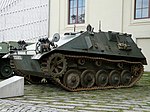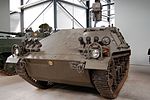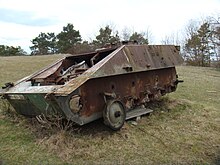Armored personnel carrier short
| Armored personnel carrier (short) | |
|---|---|

SPz 11-2 in the Munster tank museum |
|
| General properties | |
| crew | 4–5 (commander, driver, radio operator, gunner) |
| length | 4.51 m |
| width | 2.28 m |
| height | 1.97 m |
| Dimensions | 8.2 t |
| Armor and armament | |
| Armor | 8-30 mm |
| Main armament | 20-mm automatic cannon HS 820 L / 85 |
| Secondary armament | Smoke throwing system with 2 × 3 throwing cups |
| agility | |
| drive |
Six cylinders - V-engine , Otto engine type Hotchkiss 121 kW (164 hp) |
| suspension | Torsion bar suspension with mech. Shock absorbers |
| Top speed | 58 km / h |
| Power / weight | 20.5 hp / t |
| Range | approx. 400 km |
The short armored personnel carrier (SPz short, Hotchkiss ) belonged to the initial equipment of the Bundeswehr with armored vehicles . The vehicle was based on the TT 6 armored personnel carrier from the French company Hotchkiss-Brandt , whose track drive was expanded to include an additional roller (five in total). In addition, there was the "armored personnel carrier (long) HS 30 " in the German army .
The Klöckner-Humboldt-Deutz plant in Mainz produced over 1,600 vehicles under license from 1959 to 1967. The best-known version was the Spähpanzer , which was used for easy reconnaissance in a squad with two vehicles.
rating
Like the armored personnel carrier (long) HS 30 , the Hotchkiss also had its weaknesses: It was relatively slow and quite loud for reconnaissance, and due to the high gear ratio, reversing was only possible at a little more than walking speed (6 km / h). Furthermore, the quick-release axles of the drive wheels in the front were vulnerable and quickly broke when entering a ditch.
Changing the ammunition for the 20 mm cannon was difficult due to the limited space and the high weight of the belt; the change also required the use of tools. The infantry fighting vehicle did not have an optical rangefinder, so the distance had to be estimated.
In winter only the driver benefited minimally from the weak heating; the rest of the crew froze, although missions lasting several days were the rule. Another drawback was that there were hardly any or not at all secured circuits. Radio operation was only possible if the entire on-board network was switched on with the battery switch ("NATO bone"). Since the ignition coil was then also under voltage, there were occasional short circuits with corresponding consequences. The fuel system also suffered from leaks. The low silhouette, which made it difficult to detect, was advantageous.
From 1962, the vehicles were retrofitted with smoke throw systems. The Type 11-2 variant remained in service with the tank reconnaissance force until 1982 and the Type 91-2 version with reconnaissance radar even until 1987. All others were replaced by Fuchs and M113 MTW vehicles at the end of the 1970s . Most of the vehicles ended up as hard targets on military training areas. A few specimens found their way into museums or private hands. The troops often referred to the vehicle as a “brake block”, “wheel chock” or “combat wheelchair”.
Versions
In addition to the basic version Type 11-2 with a manually pivoting turret with a 20 mm HS 820 / L85 automatic cannon from the Geneva armaments company Hispano-Suiza (Suisse) as an armored personnel carrier for a half group of four to five men in the armored reconnaissance force , the following variants exist:
| Surname | description | image |
|---|---|---|
| Type 2-2 | Ambulance with two stretchers and a driver and a medic as a crew. |

|
| Type 22-2 | Observation tank with improved radio equipment and a three-man crew. This version was called a so-called by the artillery troops. VB vehicle (forward observer) deployed. The radio equipment consisted of one or two SEM 35 devices or one SEM 35 and one EM 35 each. It was also equipped with a MG3 with 7.62 mm caliber including anti-aircraft visor, 2 × 3 smoke cannons and a periscope. |

|
| Type 42-1 | Transport tank "cargo" with unprotected transport platform / two bench seats and only four castors each |

|
| Type 51-2 | Tank mortar with a Tampella 81 mm mortar and a supply of 51 rounds of ammunition, built between 1959 and 1964 and used until 1969. |

|
| Type 91-2 | Radar reconnaissance tank with battlefield radar AN / TPS 33a, range 18,000 meters and reinforced radio equipment, used until 1987. |

|
Technical specifications
(Type 11-2 as reconnaissance tank)
- Combat weight 8,400 kg
- Length 4.47 m
- Width 2.34 m
- Height 2.02 m (without antenna)
- Chain drive with five rollers and three support rollers
- Crew: 4 men (commander in the tower, driver, radio operator at the rear left, observer at the rear right, emergency seat for the 5th man in front of it)
- Armor 8 mm / directly forward 20 mm
- When the hatches are closed, view for the driver and commanders through periscopes , for observers to the right through 50 mm bulletproof glass (can be folded away)
- Rolls-Royce - six-cylinder engine ( Otto engine ), displacement 4678 cm³, 164 hp
- Top speed: 58 km / h (backwards 6 km / h)
- Range: approx. 400 km (road)
- Gradeability : 60%
- Trench crossing ability: 1.50 m
- mirror image H-shift (1st gear bottom left)
- Steering by steering lever via chain brakes
- additional foot brake ( band brake ), this should only be used for emergency braking, as it was sensitive and often did not come off by itself after use.
- Wading depth : 0.70 m
- Climbing ability: 0.60 m
- Fuel tank: 330 l
- Armament:
- 20 mm automatic cannon ( Hispano-Suiza 820 / L 85) in the turret to the left of the commander for:
- Explosive incendiary ammunition on a decay belt for fighting soft targets and for anti-aircraft defense, as well as armor-piercing ammunition in magazines.
- Rate of fire ( cadence ) with decay belt: approx. 800–1000 rounds / min
- Combat range: 400–1200 meters, maximum shooting range: approx. 7.5 km
- Standard close combat equipment (STAN armament) of the crew: Commander with P1 pistol , driver and radio operator with MPi 2 submachine gun , scout with G3 rifle .
- Two tailgates with aluminum storage boxes. In some brigades, a stowage grille at the front to hold the crew's storm luggage (right tank in the picture above).
literature
- Dieter H. Kollmer: “Block, don't mess!” The material armament of the army from the beginning to the end of the sixties. In: Helmut R. Hammerich, Dieter H. Kollmer, Martin Rink , Rudolf J. Schlaffer: Das Heer 1950 to 1970. Concept, organization, installation. R. Oldenbourg Verlag , Munich 2006, pp. 595ff., ISBN 3-486-57974-6 .
- Werner Oswald : Motor vehicles and tanks of the Reichswehr, Wehrmacht and Bundeswehr. Motorbuchverlag, Stuttgart 1992, ISBN 3-87943-850-1 .
- The friction . Manual for the German soldiers. Verlag ES Mittler & Sohn , ISBN 3-8132-0820-6 .
- Karl Anweiler, Rainer Blank: The wheeled and tracked vehicles of the Bundeswehr from 1956 to the present day. Bechtermünz-Verlag, 1999, ISBN 3-8289-5369-7 .
- Peter Blume: Armored personnel carrier short, Hotchkiss / long, HS 30 Tankgrad Publishing - Verlag Jochen Vollert, 2008.
Web links
Individual evidence
- ↑ Armored personnel carrier, Hotchkiss, Peter Blume, Tankograd Publishing
- ^ Karl Anweiler, Rainer Blank: The wheeled and tracked vehicles of the Bundeswehr 1956 to today. P. 292
- ^ Karl Anweiler, Rainer Blank: The wheeled and tracked vehicles of the Bundeswehr 1956 to today. P. 295
- ^ Karl Anweiler, Rainer Blank: The wheeled and tracked vehicles of the Bundeswehr 1956 to today. P. 296
- ^ Karl Anweiler, Rainer Blank: The wheeled and tracked vehicles of the Bundeswehr 1956 to today. P. 293
- ^ Karl Anweiler, Rainer Blank: The wheeled and tracked vehicles of the Bundeswehr 1956 to today. P. 293




